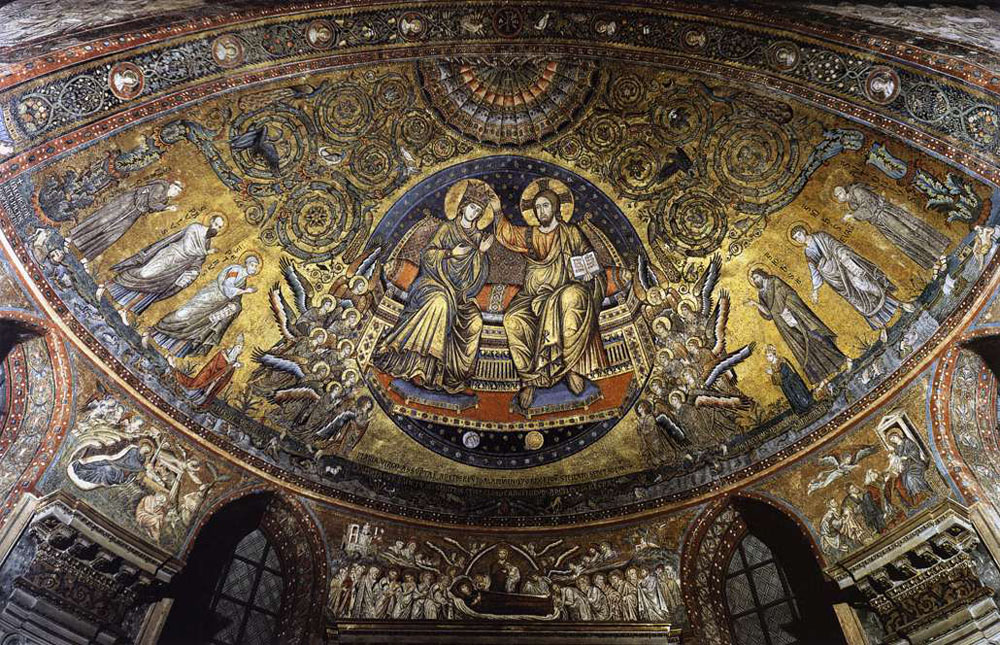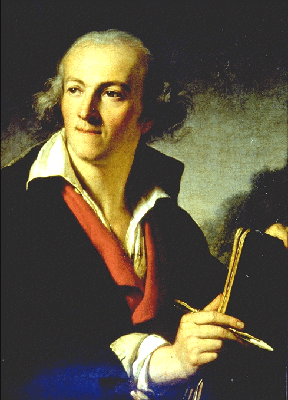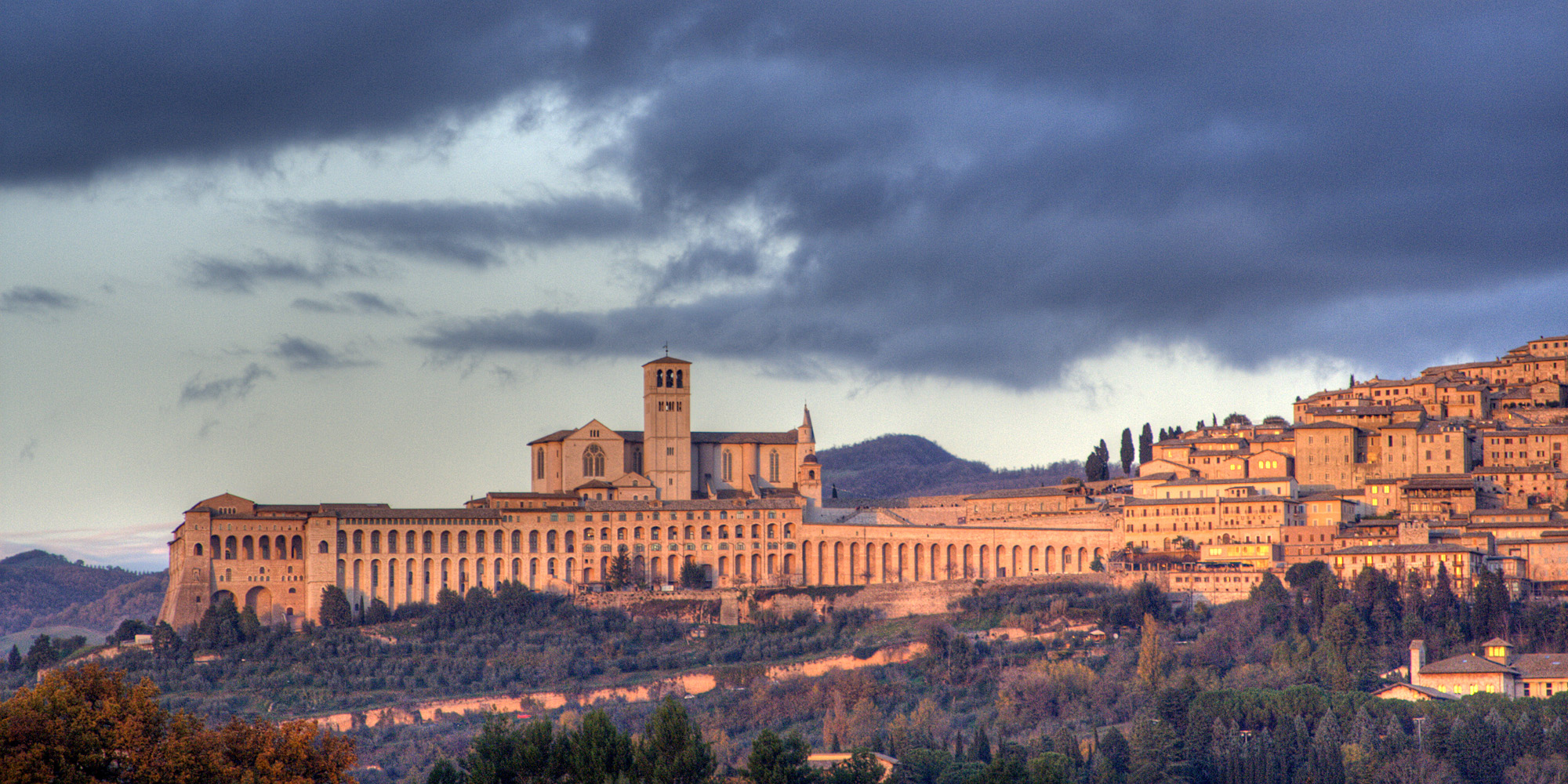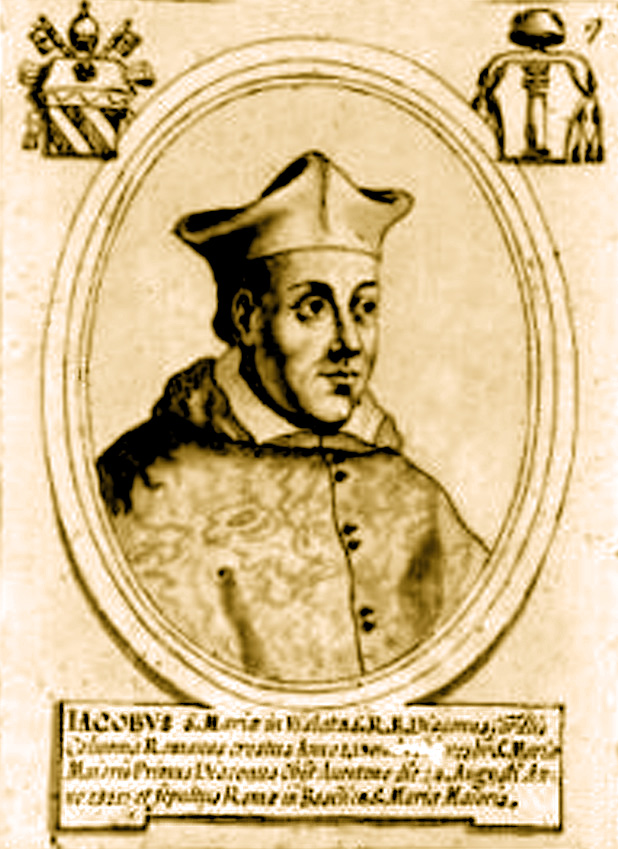|
Jacopo Torriti
Jacopo Torriti or Turriti was an Italian painter and mosaic maker who lived in the 13th century. He worked in the decoration especially in the apse of San Giovanni in Laterano and Santa Maria Maggiore in Rome. Those in the Lateran were carried out in conjunction with the Franciscan friar, Jacopo Camerino. They were executed between the years 1287 and 1292, and though in imitation of the style of Cimabue. There are no written documents about his life. In 1291 he signed the apse mosaics in the basilica San Giovanni in Laterano in Rome, which was nearly all redone in 1878. The mosaics of the apse in Santa Maria Maggiore were executed by him in 1295. They depict the Coronation of the Virgin by Christ in a large medallion. The medallion is encircled with a sprawling floral ornament with flowers, birds and animals, this probably original from the 4th century. In the lower strip of the mosaic we can see the standing figures of St Peter, St Paul and Pope Nicholas IV (left side), and S ... [...More Info...] [...Related Items...] OR: [Wikipedia] [Google] [Baidu] |
Jacopo Torriti, Coronation Of The Virgin, Santa Maria Maggiore, Rome
Jacopo (also Iacopo) is a masculine Italian language, Italian given name, derivant from Latin language, Latin ''Iacōbus''. It is an Italian variant of Giacomo. * Jacopo Aconcio (), Italian religious reformer * Jacopo Bassano (1592), Italian painter * Iacopo Barsotti (1921–1987), Italian mathematician * Jacopo da Bologna (), Italian composer * Tintoretto, Jacopo Comin (1518–1594), Italian painter otherwise known as Tintoretto * Pontormo, Jacopo Carucci (1494–1557), Italian painter otherwise known as Pontormo * Jacopo Corsi (1561–1602), Italian composer * Jacopo da Leona (died 1277), Italian poet * Jacopo Peri (1561–1633), Italian composer * Jacopo della Quercia (1438), Italian sculptor * Jacopo Riccati (1676–1754), Italian mathematician * Jacopo Sadoleto (1477–1547), Italian Catholic cardinal * Jacopo M. (1989), Italian Communicator, upholder of the European Commission Fictional characters: * Jacopo, a key character in the 2002 film version of ''The Count of Monte Cri ... [...More Info...] [...Related Items...] OR: [Wikipedia] [Google] [Baidu] |
St James The Great
James the Great, also known as James, son of Zebedee, Saint James the Great, Saint James the Greater, Saint James the Elder, or Saint Jacob (Aramaic ܝܥܩܘܒ ܒܪ ܙܒܕܝ, Arabic يعقوب, Hebrew בן זבדי , '' Yaʿăqōḇ'', Latin ''Iacobus Maior'', Greek Ἰάκωβος τοῦ Ζεβεδαίου ''Iákōbos tû Zebedaíou''; died AD 44), was one of the Twelve Apostles of Jesus, the first apostle to be martyred according to the New Testament. Saint James is the patron saint of Spain and, according to tradition, his remains are held in Santiago de Compostela in Galicia. In the New Testament The son of Zebedee and Salome, James is styled "the Greater" to distinguish him from the Apostle James "the Less", with "greater" meaning older or taller, rather than more important. James the Great was the brother of John the Apostle. James is described as one of the first disciples to join Jesus. The Synoptic Gospels state that James and John were with their father by the se ... [...More Info...] [...Related Items...] OR: [Wikipedia] [Google] [Baidu] |
Mosaic Artists
A mosaic is a pattern or image made of small regular or irregular pieces of colored stone, glass or ceramic, held in place by plaster/mortar, and covering a surface. Mosaics are often used as floor and wall decoration, and were particularly popular in the Ancient Roman world. Mosaic today includes not just murals and pavements, but also artwork, hobby crafts, and industrial and construction forms. Mosaics have a long history, starting in Mesopotamia in the 3rd millennium BC. Pebble mosaics were made in Tiryns in Mycenean Greece; mosaics with patterns and pictures became widespread in classical times, both in Ancient Greece and Ancient Rome. Early Christian basilicas from the 4th century onwards were decorated with wall and ceiling mosaics. Mosaic art flourished in the Byzantine Empire from the 6th to the 15th centuries; that tradition was adopted by the Norman Kingdom of Sicily in the 12th century, by the eastern-influenced Republic of Venice, and among the Rus. Mosaic fell o ... [...More Info...] [...Related Items...] OR: [Wikipedia] [Google] [Baidu] |
Catholic Painters
The Catholic Church, also known as the Roman Catholic Church, is the largest Christian church, with 1.3 billion baptized Catholics worldwide . It is among the world's oldest and largest international institutions, and has played a prominent role in the history and development of Western civilization. O'Collins, p. v (preface). The church consists of 24 ''sui iuris'' churches, including the Latin Church and 23 Eastern Catholic Churches, which comprise almost 3,500 dioceses and eparchies located around the world. The pope, who is the bishop of Rome, is the chief pastor of the church. The bishopric of Rome, known as the Holy See, is the central governing authority of the church. The administrative body of the Holy See, the Roman Curia, has its principal offices in Vatican City, a small enclave of the Italian city of Rome, of which the pope is head of state. The core beliefs of Catholicism are found in the Nicene Creed. The Catholic Church teaches that it is the ... [...More Info...] [...Related Items...] OR: [Wikipedia] [Google] [Baidu] |
Italian Male Painters
Italian(s) may refer to: * Anything of, from, or related to the people of Italy over the centuries ** Italians, an ethnic group or simply a citizen of the Italian Republic or Italian Kingdom ** Italian language, a Romance language *** Regional Italian, regional variants of the Italian language ** Languages of Italy, languages and dialects spoken in Italy ** Italian culture, cultural features of Italy ** Italian cuisine, traditional foods ** Folklore of Italy, the folklore and urban legends of Italy ** Mythology of Italy, traditional religion and beliefs Other uses * Italian dressing, a vinaigrette-type salad dressing or marinade * Italian or Italian-A, alternative names for the Ping-Pong virus, an extinct computer virus See also * * * Italia (other) * Italic (other) * Italo (other) * The Italian (other) The Italian may refer to: * ''The Italian'' (1915 film), a silent film by Reginald Barker * ''The Italian'' (2005 film), a Russian film by A ... [...More Info...] [...Related Items...] OR: [Wikipedia] [Google] [Baidu] |
14th-century Italian Painters
As a means of recording the passage of time, the 14th century was a century lasting from 1 January 1301 ( MCCCI), to 31 December 1400 (MCD). It is estimated that the century witnessed the death of more than 45 million lives from political and natural disasters in both Europe and the Mongol Empire. West Africa experienced economic growth and prosperity. In Europe, the Black Death claimed 25 million lives wiping out one third of the European population while the Kingdom of England and the Kingdom of France fought in the protracted Hundred Years' War after the death of Charles IV, King of France led to a claim to the French throne by Edward III, King of England. This period is considered the height of chivalry and marks the beginning of strong separate identities for both England and France as well as the foundation of the Italian Renaissance and Ottoman Empire. In Asia, Tamerlane (Timur), established the Timurid Empire, history's third largest empire to have been ever establis ... [...More Info...] [...Related Items...] OR: [Wikipedia] [Google] [Baidu] |
Museum Of Grenoble
The Museum of Grenoble (french: Musée de Grenoble) is a municipal museum of Fine Arts and antiquities in the city of Grenoble in the Isère region of France. Located on the left bank of the Isère River, place Lavalette, it is known both for its collections of ancient art for its collections of modern and contemporary art. Thanks to the action of one of its curators of the interwar period (Andry-Farcy), it is considered the very first museum of modern art in France. Its temporary rooms allow it to organize two exhibitions each year. History The Museum of Grenoble was founded on 16 February 1798 by Louis-Joseph Jay, well before other French provincial museums. That day, an order of the local administration detailed the creation of a ''museum'' in Grenoble, in which article 10 stipulated that « the citizen Louis-Joseph Jay is appointed curator of this museum. » In May of that year, the Interior Minister canceled the creation of the museum but a provisional authorization w ... [...More Info...] [...Related Items...] OR: [Wikipedia] [Google] [Baidu] |
Tre Fontane
Tre Fontane Abbey ( en, Three Fountains Abbey; la, Abbatia trium fontium ad Aquas Salvias), or the Abbey of Saints Vincent and Anastasius, is a Roman Catholic abbey in Rome, held by monks of the Cistercian Order of the Strict Observance, better known as Trappists. It is known for raising the lambs whose wool is used to weave the pallia of new metropolitan archbishops. The Pope blesses the lambs on the Feast of Saint Agnes on January 21. The wool is prepared, and he gives the pallia to the new archbishops on the Solemnity of Saints Peter and Paul, the Holy Apostles. History of the abbey Belonging to the monastery are three separate churches. The first, the Church of St. Paul of Three Fountains, was raised on the spot where St. Paul was beheaded by order of the Emperor Nero. Legend accounts for the three springs (''fontane'') with the assertion that, when severed from Paul's body, his head bounced and struck the earth in three different places, from which fountains sprang up. ... [...More Info...] [...Related Items...] OR: [Wikipedia] [Google] [Baidu] |
Basilica Of Saint Francis Of Assisi
The Basilica of Saint Francis of Assisi ( it, Basilica di San Francesco d'Assisi; la, Basilica Sancti Francisci Assisiensis) is the mother church of the Roman Catholic Order of Friars Minor Conventual in Assisi, a town in the Umbria region in central Italy, where Saint Francis was born and died. It is a Papal minor basilica and one of the most important places of Christian pilgrimage in Italy. With its accompanying friary, Sacro Convento, the basilica is a distinctive landmark to those approaching Assisi. It has been a UNESCO World Heritage Site since 2000. The basilica, which was begun in 1228, is built into the side of a hill and comprises two churches (known as the Upper Church and the Lower Church) and a crypt, where the remains of the saint are interred. The interior of the Upper Church is an important early example of the Gothic style in Italy. The Upper and Lower Churches are decorated with frescoes by numerous late medieval painters from the Roman and Tuscan scho ... [...More Info...] [...Related Items...] OR: [Wikipedia] [Google] [Baidu] |
Middle Ages
In the history of Europe, the Middle Ages or medieval period lasted approximately from the late 5th to the late 15th centuries, similar to the post-classical period of global history. It began with the fall of the Western Roman Empire and transitioned into the Renaissance and the Age of Discovery. The Middle Ages is the middle period of the three traditional divisions of Western history: classical antiquity, the medieval period, and the modern period. The medieval period is itself subdivided into the Early Early may refer to: History * The beginning or oldest part of a defined historical period, as opposed to middle or late periods, e.g.: ** Early Christianity ** Early modern Europe Places in the United States * Early, Iowa * Early, Texas * Early ..., High Middle Ages, High, and Late Middle Ages. Population decline, counterurbanisation, the collapse of centralized authority, invasions, and mass migrations of tribes, which had begun in late antiquity, continued i ... [...More Info...] [...Related Items...] OR: [Wikipedia] [Google] [Baidu] |
Giacomo Colonna (cardinal)
Giacomo or Jacopo Colonna (1250 – 14 August 1318) was a member of a powerful noble family in Rome, and an Italian cardinal. Life Giacomo Colonna was the second son of Oddone and Margherita Orsini Colonna, and as such, a member of two of the most powerful and influential families in Rome. He was an older brother of Blessed Margherita Colonna. His father died when he was still a boy. His mother, a pious woman, was sister to Matteo Rosso Orsini. When she died, about 1570, Giacomo and his older brother, Giovanni, looked after their younger sister. Colonna studied law at the University of Bologna. When Margherita reached her late teens there was talk of arranging an appropriate marriage for her. However, she preferred to retire to religious life. She was initially opposed by her brother Giovanni, but supported by Giacomo, a Franciscan friar. At the consistory of 12 March 1278, his first cousin, Pope Nicholas III created him a cardinal, naming him cardinal deacon of Santa M ... [...More Info...] [...Related Items...] OR: [Wikipedia] [Google] [Baidu] |
Anthony The Great
Anthony the Great ( grc-gre, Ἀντώνιος ''Antṓnios''; ar, القديس أنطونيوس الكبير; la, Antonius; ; c. 12 January 251 – 17 January 356), was a Christian monk from Egypt, revered since his death as a saint. He is distinguished from other saints named Anthony, such as , by various epithets: , , , , , and . For his importance among the Desert Fathers and to all later Christian monasticism, he is also known as the . His feast day is celebrated on 17 January among the Orthodox and Catholic The Catholic Church, also known as the Roman Catholic Church, is the List of Christian denominations by number of members, largest Christian church, with 1.3 billion baptized Catholics Catholic Church by country, worldwide . It is am ... churches and on month of Tobi, Tobi 22 in the Coptic calendar. The biography of Anthony's life by Athanasius of Alexandria helped to spread the concept of Christian monasticism, particularly in Western Europe v ... [...More Info...] [...Related Items...] OR: [Wikipedia] [Google] [Baidu] |


.jpg)





